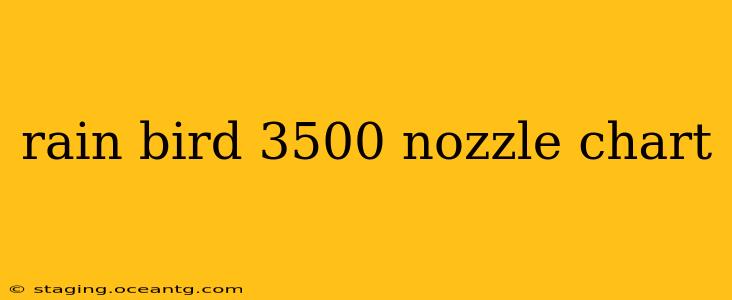The Rain Bird 3500 series rotors are a popular choice for irrigation professionals and homeowners alike, known for their reliability and adjustable spray patterns. Understanding the Rain Bird 3500 nozzle chart is crucial for achieving optimal water coverage and efficient irrigation. This guide will not only explain how to interpret the chart but also provide helpful tips and considerations for choosing the right nozzle for your specific landscaping needs.
What is a Rain Bird 3500 Nozzle Chart?
A Rain Bird 3500 nozzle chart is a reference guide that details the various nozzle options available for the 3500 series rotors. It displays key performance characteristics of each nozzle, allowing you to select the best one for your specific irrigation needs. These characteristics typically include:
- Nozzle size (inches): This indicates the diameter of the nozzle orifice, directly impacting the water flow rate and throw distance.
- Radius (feet): This refers to the distance the water spray travels from the rotor head. This is crucial for determining the spacing between your sprinkler heads.
- Precipitation rate (inches per hour): This shows the amount of water applied per hour, critical for preventing runoff and ensuring even watering.
Understanding the Key Specifications on the Chart
The chart itself typically presents the information in a table format, making it easy to compare different nozzles. Look for columns indicating nozzle size, radius (often in multiple arcs), and precipitation rate. You may also find information on arc adjustment, which allows you to customize the spray pattern (e.g., 90°, 180°, 270°, or 360°).
Interpreting the Data: For instance, you might see a row indicating a 4.0-inch nozzle with a radius of 40 feet at a 360° arc and a precipitation rate of 1 inch per hour. This means that this particular nozzle will water a 40-foot radius circle at a rate of 1 inch of water per hour.
How to Choose the Right Rain Bird 3500 Nozzle
Choosing the correct nozzle depends on several factors:
- Area to be watered: Measure the area needing irrigation to determine the required radius. Remember, you'll need multiple heads to cover large areas.
- Spacing between rotors: Proper spacing ensures even coverage and prevents overlap or gaps in watering. The chart helps you determine the ideal distance between heads based on the chosen nozzle's radius.
- Water pressure: Your water pressure significantly influences the rotor's performance. Consult the chart and your water pressure to select a nozzle that operates efficiently within your system's capabilities. Higher pressure may require smaller nozzles to avoid overwatering.
- Soil type and plant requirements: Different plants have different water needs. Sandy soil requires more frequent, lighter watering compared to clay soil. The precipitation rate helps ensure you're supplying the appropriate amount of water.
- Desired precipitation rate: The chart provides the precipitation rate for each nozzle. Choose a nozzle that provides the desired rate based on your soil type and plant needs to avoid runoff or underwatering.
Where Can I Find the Rain Bird 3500 Nozzle Chart?
While a physical chart might not always be readily available, you can easily find the necessary information on the Rain Bird website. Their website provides detailed specifications for all their products, including the 3500 series rotors. Search for "Rain Bird 3500 specifications" or "Rain Bird 3500 nozzle chart" to find the most up-to-date information.
What if I Can't Find the Specific Nozzle I Need?
If you can't find a nozzle that perfectly matches your needs, consider adjusting your rotor spacing or consulting with an irrigation professional. They can assist in designing a system that effectively waters your landscape using the available nozzles.
What are the Different Arc Options Available for Rain Bird 3500 Nozzles?
The Rain Bird 3500 series nozzles offer various arc options, typically including full circle (360°), 270°, 180°, and 90°. This allows flexibility in designing irrigation systems for various landscape shapes and sizes. Choosing the correct arc is essential for efficient water usage and avoiding overwatering.
How Do I Calculate the Number of Rain Bird 3500 Rotors Needed?
Calculating the number of rotors needed requires considering the coverage area of each nozzle and the overall area you need to irrigate. You will need to divide the total area by the area covered by a single rotor, ensuring adequate overlap to avoid gaps in coverage. Consider the shape of the area and the various arc options available to optimize rotor placement.
This comprehensive guide helps you understand and utilize the Rain Bird 3500 nozzle chart effectively. Remember to always consult the official Rain Bird resources for the most accurate and up-to-date information.
